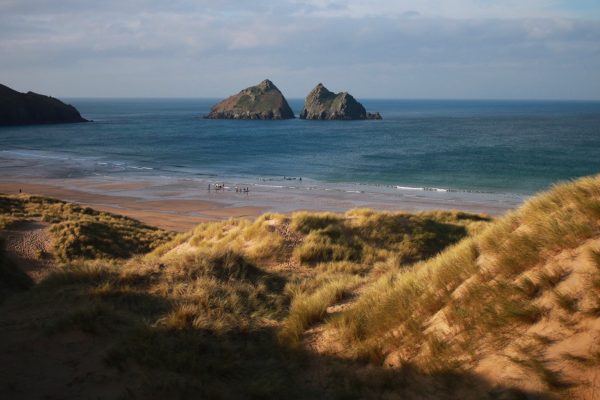How are we connected? A view from SETAC
This blog is guest-authored by Erica K. Brockmeier and is also available here.
Oceans provide more for us than our annual summer holidays—they help connect people, deliver materials across the world, are a source of economic growth for coastal communities, provide food, medicine, and can help moderate climate change.
But our strong connection to the marine environment also comes with some drawbacks. Seafood contamination, marine pollution, biological hazards such as red tides and antimicrobial resistance, and rising sea levels are just a few of the examples of how our own health is closely linked to the health of our environment.
A new and rapidly expanding field of research called Oceans and Human Health is focused on looking at the connections between our health and the health of marine environments. This work includes looking at both the benefits and the risks to people and how our actions can influence the health of marine ecosystems.
The theme of oceans and human health was prevalent at this year’s SETAC Brussels meeting, where the goal of the Keynote and Platform Presentations was to explore the interconnections between environmental science and human health.
“This area of research is very strategically important for the world, and very important for SETAC as an organization, to move into” said Colin Janssen, one of the co-chairs of the oceans and health session. “SETAC researchers are now beginning to focus more on the marine environment, as we are recognizing more and more that human health is not isolated from the environment’s health.”
A discussion around the theme was kicked off at the Opening Keynote Presentation by Professor Lora Fleming, and was followed by a series of platform and poster presentations at the start of the conference.
The science that connects oceans and human health
Lora Fleming presented her collaborative work on red tide events in the state of Florida. Red tide is caused by microscopic algae (Karenia brevis) that release neurotoxins as aerosols which are then transmitted by air and wind. Large outbreaks in Southwestern Florida were responsible for the deaths of many endangered Florida manatee and dolphin populations.
One significant result from this work was the finding that dolphins had eaten fish with trace amounts of red tide neurotoxin. Since dolphins do not eat dead fish and it was previously thought that fish consumption did not confer a risk to neurotoxin exposure, these findings provided new evidence of the risks of consuming fish during red tide events. Fleming’s research team provided evidence to change existing policies for red tide event management in order to better protect both marine and human health.
The human health impacts of red tide events could also be seen beyond the beach where direct exposure occurs. Fleming and her team found that red tide outbreaks were linked to increases in emergency room admissions and exacerbated breathing problems for people with respiratory conditions such as asthma. This work highlights the pervasive nature of red tide events and provides a better understanding of how people are affected by the health of the marine environment.
Maarten de Rijcke from Ghent University later presented results of a study focused on red tide pollution in the North Sea. Rijcke and his team placed caged mussels at in a coastal sluice dock and looked for algal bloom neurotoxins in the mussels. Researchers found a complex mixture of toxins present in the mussels after only 15 days and several of the neurotoxins they found had unknown toxicities.
Rijcke highlighted the importance for looking at algal bloom toxins levels in economically-important species, as well as the importance of looking at toxins more broadly, instead of only focusing on neurotoxins of known toxicities. He stated that chemicals which are not regularly monitored or for which no toxicity data exist might still have a negative impact on human health and that these should be assessed when possible.
Antimicrobial resistance (AMR) in surfers
Anne Leonard, also from the University of Exeter, presented research on how antibiotic resistance spreads through coastal environments. Coastal areas are strongly impacted by human activities, including run-off from agricultural fields and wastewater treatment plants, and are also a place that people have the most physical contact with the ocean.
Leonard presented results of a large research study. She first collected coastal water samples and counted the numbers of E. coli that could produce a protein that is able to provide resistance to several antibiotics. Leonard then did a survey of surfers compared to non-surfers to see if there was a connection between time spent in the sea and the presence of drug-resistant E. coli. Volunteers provided rectal swabs and filled in questionnaires as part of the Beach Bum survey.
Data from the Beach Bum study shows that surfers were four times more likely to be colonized by drug-resistant E. coli when compared to people who did not surf. While there appeared to be no direct risk from the E. coli on this healthy population of surfers, Leonard commented that their presence in a healthy population means they can easily spread to more difficult-to-treat and sensitive patients. This research also shows that coastal recreational and occupational exposure to microbes might be a significant route of AMR transmission.
The benefits of interacting with the oceans
Fleming shifted the tone of the platform presentations to focus on the benefits gained through positive interactions with marine environments. She presented a summary of results from scientific surveys, interviews, and controlled experiments in the UK. This includes better health reported in people who live close to the ocean or other bodies of water, with the strongest effects seen in poorer communities. Her group also found a reported reduction in stress and an increase in physical activity after people visited coastal areas.
Researchers also found that people who visited marine areas reported increased interactions among family members and had increased vitamin D levels. Fleming and her group are now working to understand and consolidate the benefits of ‘blue gyms’ in the UK, findings which consistently demonstrate positive benefits from interactions with healthy marine environments.
A potential mechanism behind positive interactions with marine environments?
Michael Moore from Plymouth University proposed a hypothesis that low-dose recurring exposures to the natural by-products of marine microorganisms provide a direct health benefit to human populations. Moore presented support for his idea that these by-products reduce the activities of the mechanistic target of rapamycin (mTOR) pathway.
The mTOR pathway is associated with many cancers and diseases through the immune system, and Moore’s hypothesis is based on the results of research showing the relationship between reduced mTOR signaling and increased health benefits associated with inhalation and ingestion of natural products. While Moore agrees that it is difficult to address such a large-scale idea, he is optimistic that future studies will continue to provide support for this concept which explains the positive benefits of interactions from marine and coastal environments.
What’s next for the field of oceans and human health?
A number of research projects across Europe and the United States will continue to conduct research on the connections between oceans and human health. These research projects are also looking to foster connections with other fields such as economics, psychology, and science communication.
“If we can show that oceans really are valuable, in an economic sense as well as a public health sense, and that healthy ecosystems are good for our own health and well-being, we can promote more pro-environmental behavior in people.” said Fleming. “I hope that researchers in toxicology and public health will continue to take this topic forward as a truly transdisciplinary field. That we can value and treat our world better and own what we do to the environment in a positive way.”
You can learn more about these initiatives in the EU on the Blue Health web pages and at the SeaChange ocean literacy project.




